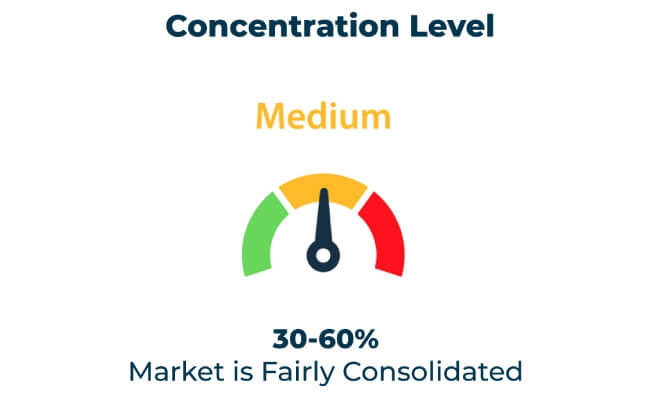The barrier shrink bags market is growing rapidly as industries seek durable, sustainable, and efficient packaging solutions for food preservation, healthcare, and industrial applications. Manufacturers are innovating with advanced materials, customizable designs, and eco-friendly practices to meet global standards. By 2035, this market is projected to exceed USD 5 billion, growing at a compound annual growth rate (CAGR) of 3.5%.
The demand for food safety, sustainability, and convenience drives market growth. Companies are delivering solutions that extend product shelf life, enhance visual appeal, and comply with rigorous packaging regulations.
| Attribute | Details |
|---|---|
| Projected Value by 2035 | USD 5 billion |
| CAGR (2025 to 2035) | 3.5% |
Factors Driving Market Growth
| Category | Market Share (%) |
|---|---|
| Top 3 Players (Amcor, Sealed Air, Kureha) | 14% |
| Rest of Top 5 Players (Winpak, Coveris) | 8% |
| Next 5 of Top 10 Players | 20% |
Type of Player & Industry Share
| Type of Player | Market Share (%) |
|---|---|
| Top 10 Players | 42% |
| Next 20 Players | 28% |
| Remaining Players | 30% |

Emerging markets in Asia-Pacific, Africa, and Latin America present significant opportunities for growth. Rising demand for packaged and frozen foods, coupled with heightened awareness of food safety, drives the need for barrier shrink bags. Exporters aligning with regional standards and preferences can capitalize on these expanding markets.
| Region | North America |
|---|---|
| Market Share (%) | 35% |
| Key Drivers | Focuses on food safety and sustainability practices. |
| Region | Europe |
|---|---|
| Market Share (%) | 30% |
| Key Drivers | Leads with strong recycling infrastructure and eco-friendly policies. |
| Region | Asia-Pacific |
|---|---|
| Market Share (%) | 25% |
| Key Drivers | Urbanization and growing packaged food demand drive growth. |
| Region | Other Regions |
|---|---|
| Market Share (%) | 10% |
| Key Drivers | Cost-effective solutions gain traction in emerging markets. |
The barrier shrink bags market will grow through sustainable materials, smart technologies, and automation. Companies investing in eco-friendly innovations and global market expansion will strengthen their leadership. Collaboration with stakeholders and compliance with global standards will further drive growth.
| Tier | Key Companies |
|---|---|
| Tier 1 | Amcor, Sealed Air, Kureha |
| Tier 2 | Winpak, Coveris |
| Tier 3 | Schur Flexibles, Plastopil |
The barrier shrink bags market is set for sustained growth as sustainability, innovation, and demand for food safety drive industry trends. Companies prioritizing eco-friendly practices, advanced materials, and emerging market opportunities will lead the way. Collaboration and compliance with global regulations will further enhance market potential.
Key Definitions
Abbreviations
Methodology
This report combines primary research, secondary data, and expert insights. Findings are validated through industry interviews to ensure accuracy and reliability.
The barrier shrink bags market includes the development and use of high-barrier, sustainable packaging solutions for food, healthcare, and industrial applications. These solutions focus on product protection, freshness, and eco-friendliness.
The food industry, healthcare, industrial goods, and retail sectors rely heavily on barrier shrink bags for protection and extended shelf life.
Manufacturers produce recyclable and biodegradable shrink bags and adopt energy-efficient production processes.
Asia-Pacific and Latin America are seeing significant growth due to expanding food processing industries, rising urbanization, and increasing demand for convenient packaged foods.
These bags are typically made from multilayer films combining materials like polyethylene (PE), polyamide (PA), and ethylene vinyl alcohol (EVOH) to provide high barrier properties and durability.
Many manufacturers are focusing on recyclable multilayer films, biodegradable options, and lightweight designs to reduce waste and environmental impact. Energy-efficient production processes also contribute to sustainability.






Full Research Suite comprises of:
Market outlook & trends analysis
Interviews & case studies
Strategic recommendations
Vendor profiles & capabilities analysis
5-year forecasts
8 regions and 60+ country-level data splits
Market segment data splits
12 months of continuous data updates
DELIVERED AS:
PDF EXCEL ONLINE
Barrier System Market Forecast Outlook 2025 to 2035
Barrier Packaging Market Size and Share Forecast Outlook 2025 to 2035
Barrier Coated Papers Market Size and Share Forecast Outlook 2025 to 2035
Barrier Tube Packaging Market Size and Share Forecast Outlook 2025 to 2035
Barrier Resins Market Size and Share Forecast Outlook 2025 to 2035
Barrier Material Market Size and Share Forecast Outlook 2025 to 2035
Barrier Coatings for Packaging Market Trends - Growth & Forecast 2025 to 2035
Barrier Film Market Trends & Industry Growth Forecast 2025 to 2035
Europe Barrier Packaging Market Growth – Demand & Forecast 2024-2034
Barrier Coated Paper Industry Analysis in Europe - Demand, Growth & Future Outlook 2025 to 2035
Japan Barrier Coated Paper Market Growth – Trends & Forecast 2023-2033
Korea Barrier Coated Paper Market Growth – Trends & Forecast 2023-2033
Competitive Landscape of Barrier Packaging Providers
Key Players & Market Share in the Barrier Coated Paper Industry
Barrier Bags Market
Barrier Shrink Bags Market Analysis - Size, Share, and Forecast 2025 to 2035
USA Barrier Coated Paper Market Size and Share Forecast Outlook 2025 to 2035
Air Barrier Market Size and Share Forecast Outlook 2025 to 2035
Non-Barrier Bag Market Size and Share Forecast Outlook 2025 to 2035
USA Barrier Packaging Market Analysis – Trends & Forecast 2024-2034

Thank you!
You will receive an email from our Business Development Manager. Please be sure to check your SPAM/JUNK folder too.
Chat With
MaRIA